Recording Transactions: Double Entry Bookkeeping & Ledgers
VerifiedAdded on 2023/06/09
|20
|4336
|237
Report
AI Summary
This report provides a comprehensive overview of bookkeeping principles and practices, focusing on the accurate and timely recording of financial transactions. It begins with an explanation of double-entry bookkeeping, detailing the steps involved in recording transactions, updating accounts, and preparing financial statements. The report then demonstrates the implementation of various business transactions using books of prime entry, ledgers, and journals, including purchases, sales, capital investments, and expense payments, with detailed journal entries and ledger postings. Furthermore, it covers the extraction of ledger balances into a trial balance to ensure the accuracy of recorded transactions and the development of a bank reconciliation statement to reconcile bank-related entries and identify errors. Finally, the report differentiates between suspense and control accounts and performs control account reconciliation for accounts receivable and payable, providing a thorough understanding of essential bookkeeping concepts and their practical application in managing financial records.
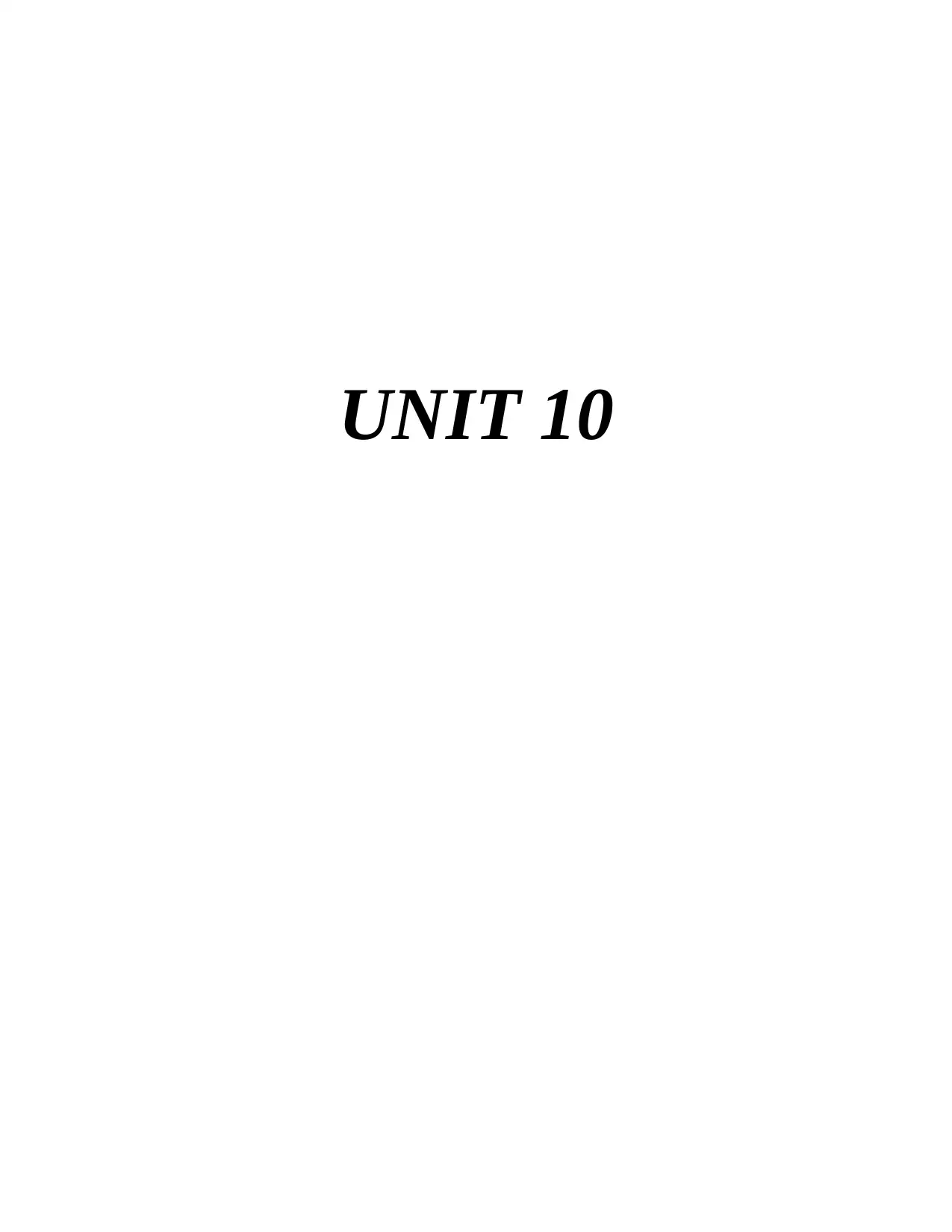
UNIT 10
Paraphrase This Document
Need a fresh take? Get an instant paraphrase of this document with our AI Paraphraser
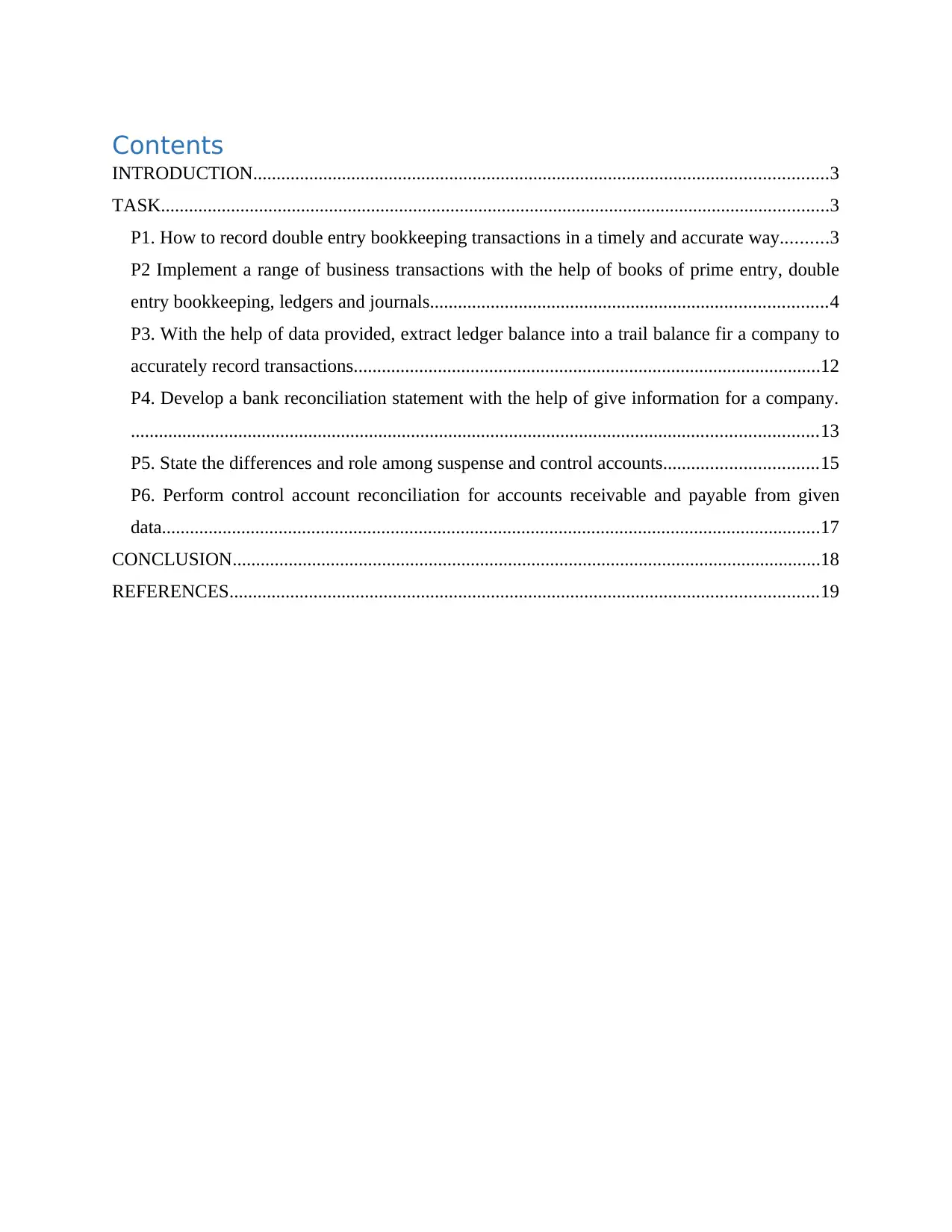
Contents
INTRODUCTION...........................................................................................................................3
TASK...............................................................................................................................................3
P1. How to record double entry bookkeeping transactions in a timely and accurate way..........3
P2 Implement a range of business transactions with the help of books of prime entry, double
entry bookkeeping, ledgers and journals.....................................................................................4
P3. With the help of data provided, extract ledger balance into a trail balance fir a company to
accurately record transactions....................................................................................................12
P4. Develop a bank reconciliation statement with the help of give information for a company.
...................................................................................................................................................13
P5. State the differences and role among suspense and control accounts.................................15
P6. Perform control account reconciliation for accounts receivable and payable from given
data.............................................................................................................................................17
CONCLUSION..............................................................................................................................18
REFERENCES..............................................................................................................................19
INTRODUCTION...........................................................................................................................3
TASK...............................................................................................................................................3
P1. How to record double entry bookkeeping transactions in a timely and accurate way..........3
P2 Implement a range of business transactions with the help of books of prime entry, double
entry bookkeeping, ledgers and journals.....................................................................................4
P3. With the help of data provided, extract ledger balance into a trail balance fir a company to
accurately record transactions....................................................................................................12
P4. Develop a bank reconciliation statement with the help of give information for a company.
...................................................................................................................................................13
P5. State the differences and role among suspense and control accounts.................................15
P6. Perform control account reconciliation for accounts receivable and payable from given
data.............................................................................................................................................17
CONCLUSION..............................................................................................................................18
REFERENCES..............................................................................................................................19
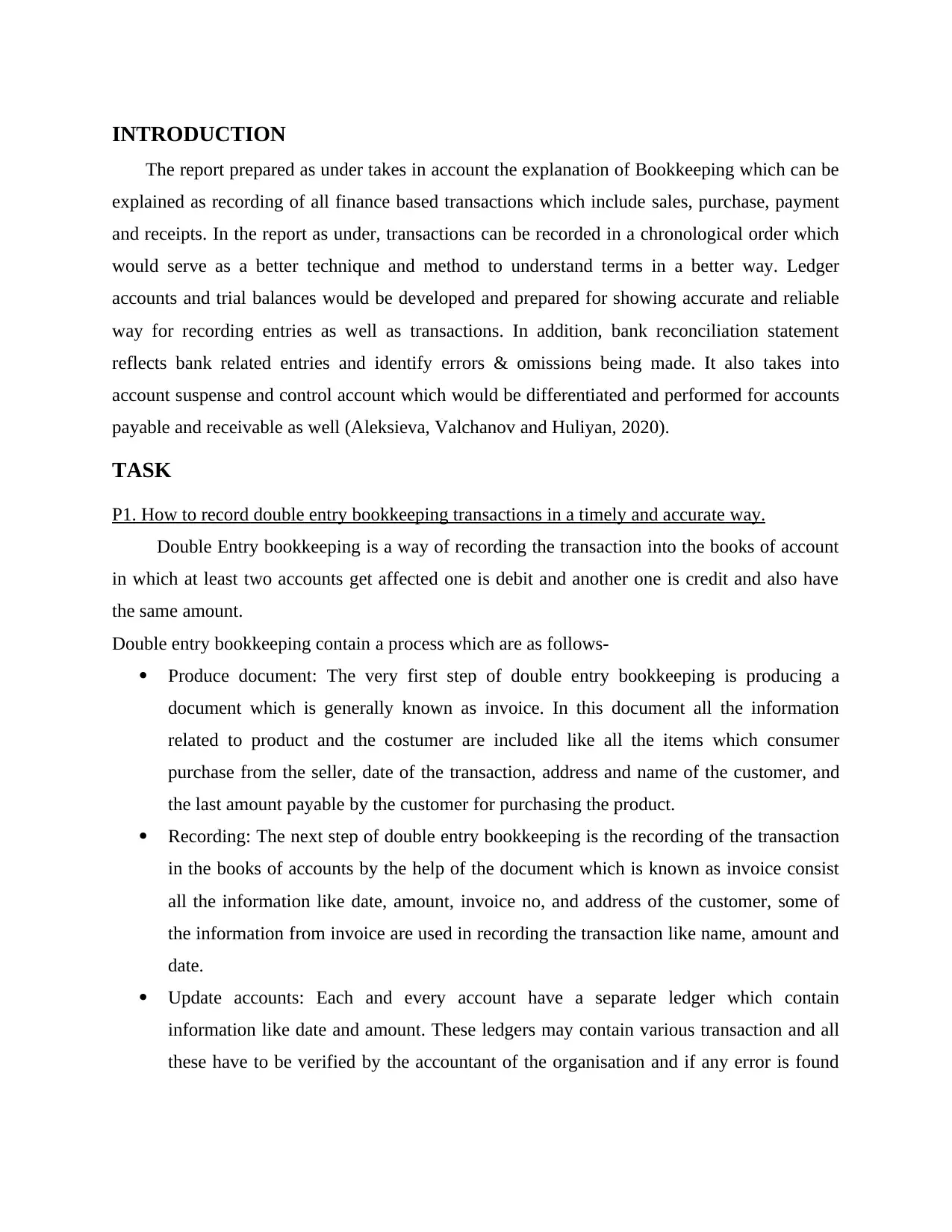
INTRODUCTION
The report prepared as under takes in account the explanation of Bookkeeping which can be
explained as recording of all finance based transactions which include sales, purchase, payment
and receipts. In the report as under, transactions can be recorded in a chronological order which
would serve as a better technique and method to understand terms in a better way. Ledger
accounts and trial balances would be developed and prepared for showing accurate and reliable
way for recording entries as well as transactions. In addition, bank reconciliation statement
reflects bank related entries and identify errors & omissions being made. It also takes into
account suspense and control account which would be differentiated and performed for accounts
payable and receivable as well (Aleksieva, Valchanov and Huliyan, 2020).
TASK
P1. How to record double entry bookkeeping transactions in a timely and accurate way.
Double Entry bookkeeping is a way of recording the transaction into the books of account
in which at least two accounts get affected one is debit and another one is credit and also have
the same amount.
Double entry bookkeeping contain a process which are as follows-
Produce document: The very first step of double entry bookkeeping is producing a
document which is generally known as invoice. In this document all the information
related to product and the costumer are included like all the items which consumer
purchase from the seller, date of the transaction, address and name of the customer, and
the last amount payable by the customer for purchasing the product.
Recording: The next step of double entry bookkeeping is the recording of the transaction
in the books of accounts by the help of the document which is known as invoice consist
all the information like date, amount, invoice no, and address of the customer, some of
the information from invoice are used in recording the transaction like name, amount and
date.
Update accounts: Each and every account have a separate ledger which contain
information like date and amount. These ledgers may contain various transaction and all
these have to be verified by the accountant of the organisation and if any error is found
The report prepared as under takes in account the explanation of Bookkeeping which can be
explained as recording of all finance based transactions which include sales, purchase, payment
and receipts. In the report as under, transactions can be recorded in a chronological order which
would serve as a better technique and method to understand terms in a better way. Ledger
accounts and trial balances would be developed and prepared for showing accurate and reliable
way for recording entries as well as transactions. In addition, bank reconciliation statement
reflects bank related entries and identify errors & omissions being made. It also takes into
account suspense and control account which would be differentiated and performed for accounts
payable and receivable as well (Aleksieva, Valchanov and Huliyan, 2020).
TASK
P1. How to record double entry bookkeeping transactions in a timely and accurate way.
Double Entry bookkeeping is a way of recording the transaction into the books of account
in which at least two accounts get affected one is debit and another one is credit and also have
the same amount.
Double entry bookkeeping contain a process which are as follows-
Produce document: The very first step of double entry bookkeeping is producing a
document which is generally known as invoice. In this document all the information
related to product and the costumer are included like all the items which consumer
purchase from the seller, date of the transaction, address and name of the customer, and
the last amount payable by the customer for purchasing the product.
Recording: The next step of double entry bookkeeping is the recording of the transaction
in the books of accounts by the help of the document which is known as invoice consist
all the information like date, amount, invoice no, and address of the customer, some of
the information from invoice are used in recording the transaction like name, amount and
date.
Update accounts: Each and every account have a separate ledger which contain
information like date and amount. These ledgers may contain various transaction and all
these have to be verified by the accountant of the organisation and if any error is found
⊘ This is a preview!⊘
Do you want full access?
Subscribe today to unlock all pages.

Trusted by 1+ million students worldwide
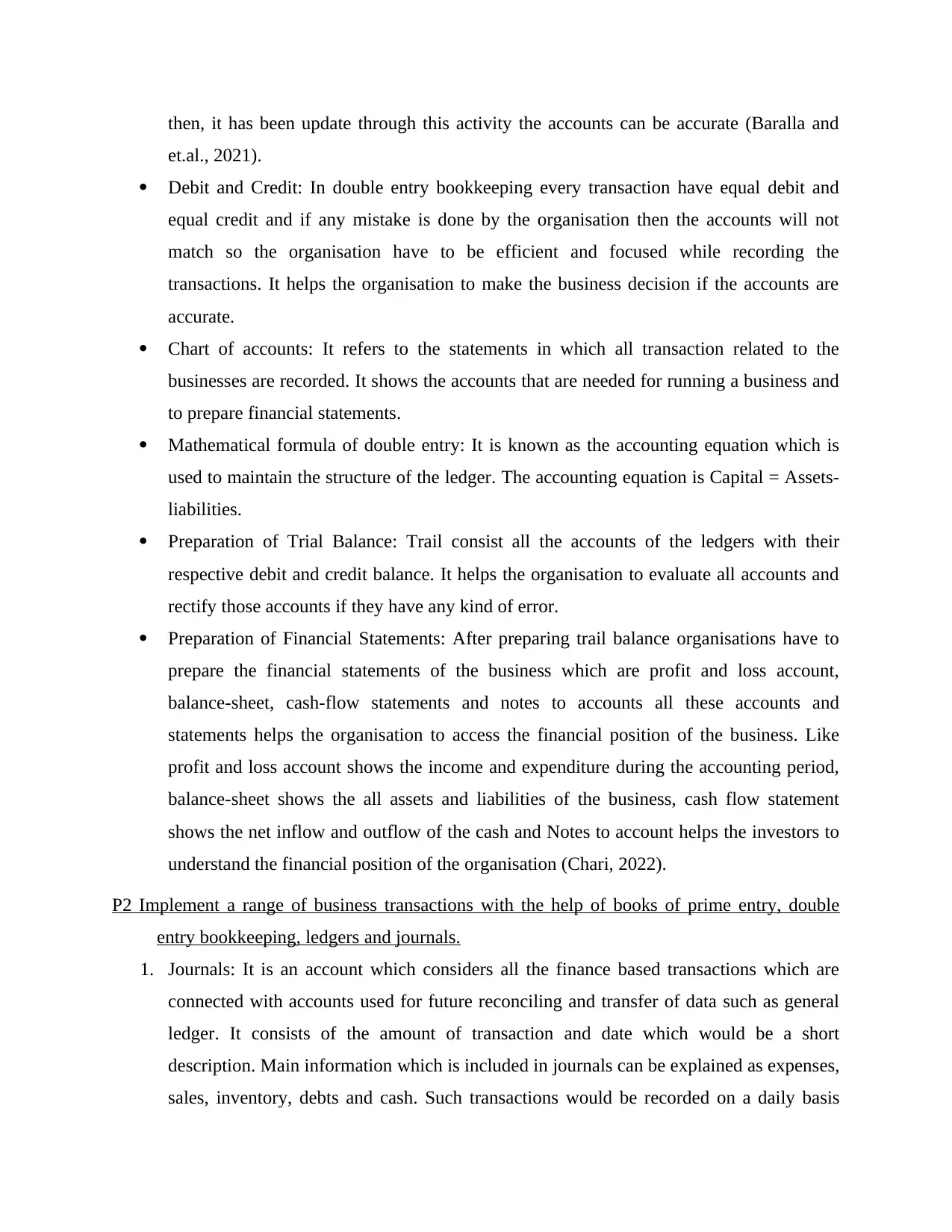
then, it has been update through this activity the accounts can be accurate (Baralla and
et.al., 2021).
Debit and Credit: In double entry bookkeeping every transaction have equal debit and
equal credit and if any mistake is done by the organisation then the accounts will not
match so the organisation have to be efficient and focused while recording the
transactions. It helps the organisation to make the business decision if the accounts are
accurate.
Chart of accounts: It refers to the statements in which all transaction related to the
businesses are recorded. It shows the accounts that are needed for running a business and
to prepare financial statements.
Mathematical formula of double entry: It is known as the accounting equation which is
used to maintain the structure of the ledger. The accounting equation is Capital = Assets-
liabilities.
Preparation of Trial Balance: Trail consist all the accounts of the ledgers with their
respective debit and credit balance. It helps the organisation to evaluate all accounts and
rectify those accounts if they have any kind of error.
Preparation of Financial Statements: After preparing trail balance organisations have to
prepare the financial statements of the business which are profit and loss account,
balance-sheet, cash-flow statements and notes to accounts all these accounts and
statements helps the organisation to access the financial position of the business. Like
profit and loss account shows the income and expenditure during the accounting period,
balance-sheet shows the all assets and liabilities of the business, cash flow statement
shows the net inflow and outflow of the cash and Notes to account helps the investors to
understand the financial position of the organisation (Chari, 2022).
P2 Implement a range of business transactions with the help of books of prime entry, double
entry bookkeeping, ledgers and journals.
1. Journals: It is an account which considers all the finance based transactions which are
connected with accounts used for future reconciling and transfer of data such as general
ledger. It consists of the amount of transaction and date which would be a short
description. Main information which is included in journals can be explained as expenses,
sales, inventory, debts and cash. Such transactions would be recorded on a daily basis
et.al., 2021).
Debit and Credit: In double entry bookkeeping every transaction have equal debit and
equal credit and if any mistake is done by the organisation then the accounts will not
match so the organisation have to be efficient and focused while recording the
transactions. It helps the organisation to make the business decision if the accounts are
accurate.
Chart of accounts: It refers to the statements in which all transaction related to the
businesses are recorded. It shows the accounts that are needed for running a business and
to prepare financial statements.
Mathematical formula of double entry: It is known as the accounting equation which is
used to maintain the structure of the ledger. The accounting equation is Capital = Assets-
liabilities.
Preparation of Trial Balance: Trail consist all the accounts of the ledgers with their
respective debit and credit balance. It helps the organisation to evaluate all accounts and
rectify those accounts if they have any kind of error.
Preparation of Financial Statements: After preparing trail balance organisations have to
prepare the financial statements of the business which are profit and loss account,
balance-sheet, cash-flow statements and notes to accounts all these accounts and
statements helps the organisation to access the financial position of the business. Like
profit and loss account shows the income and expenditure during the accounting period,
balance-sheet shows the all assets and liabilities of the business, cash flow statement
shows the net inflow and outflow of the cash and Notes to account helps the investors to
understand the financial position of the organisation (Chari, 2022).
P2 Implement a range of business transactions with the help of books of prime entry, double
entry bookkeeping, ledgers and journals.
1. Journals: It is an account which considers all the finance based transactions which are
connected with accounts used for future reconciling and transfer of data such as general
ledger. It consists of the amount of transaction and date which would be a short
description. Main information which is included in journals can be explained as expenses,
sales, inventory, debts and cash. Such transactions would be recorded on a daily basis
Paraphrase This Document
Need a fresh take? Get an instant paraphrase of this document with our AI Paraphraser
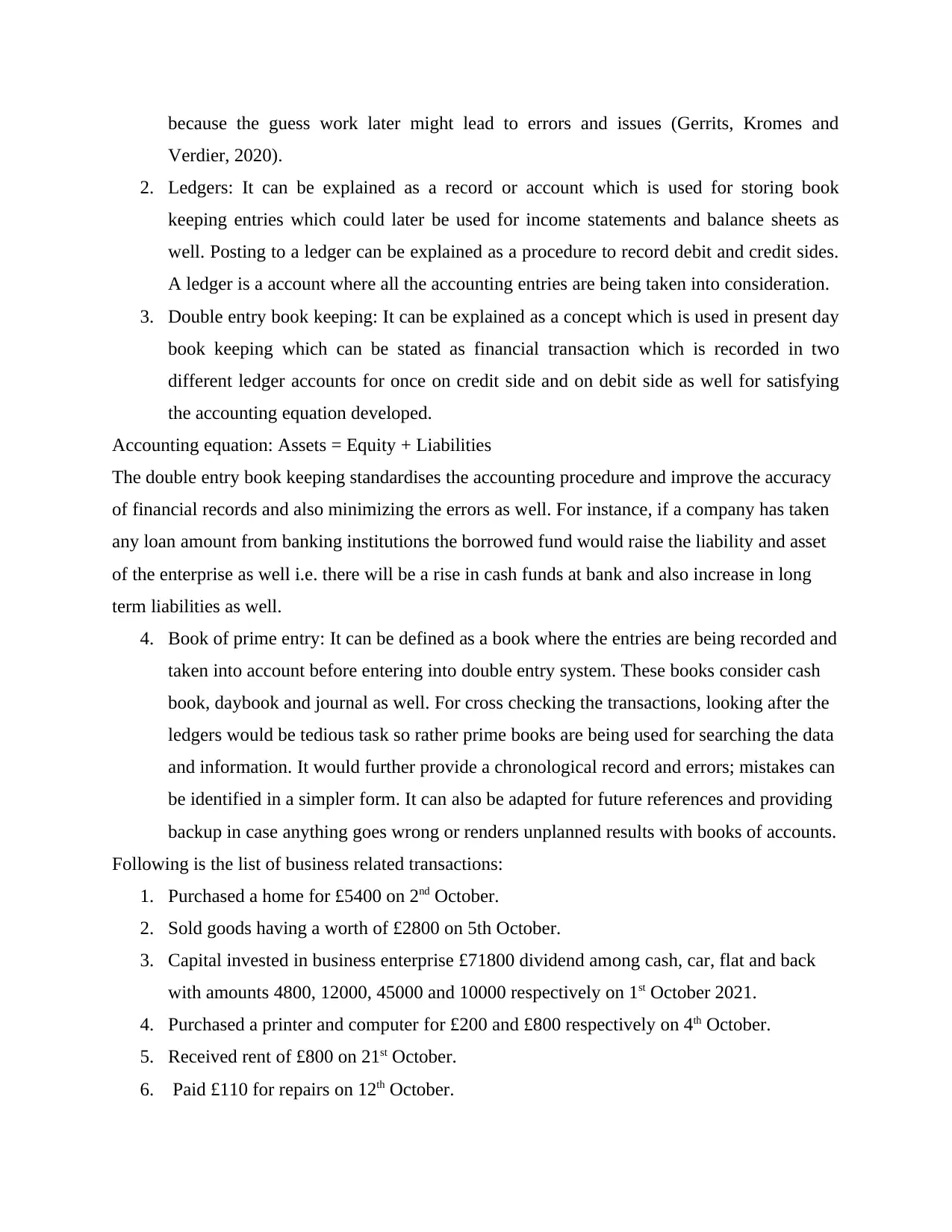
because the guess work later might lead to errors and issues (Gerrits, Kromes and
Verdier, 2020).
2. Ledgers: It can be explained as a record or account which is used for storing book
keeping entries which could later be used for income statements and balance sheets as
well. Posting to a ledger can be explained as a procedure to record debit and credit sides.
A ledger is a account where all the accounting entries are being taken into consideration.
3. Double entry book keeping: It can be explained as a concept which is used in present day
book keeping which can be stated as financial transaction which is recorded in two
different ledger accounts for once on credit side and on debit side as well for satisfying
the accounting equation developed.
Accounting equation: Assets = Equity + Liabilities
The double entry book keeping standardises the accounting procedure and improve the accuracy
of financial records and also minimizing the errors as well. For instance, if a company has taken
any loan amount from banking institutions the borrowed fund would raise the liability and asset
of the enterprise as well i.e. there will be a rise in cash funds at bank and also increase in long
term liabilities as well.
4. Book of prime entry: It can be defined as a book where the entries are being recorded and
taken into account before entering into double entry system. These books consider cash
book, daybook and journal as well. For cross checking the transactions, looking after the
ledgers would be tedious task so rather prime books are being used for searching the data
and information. It would further provide a chronological record and errors; mistakes can
be identified in a simpler form. It can also be adapted for future references and providing
backup in case anything goes wrong or renders unplanned results with books of accounts.
Following is the list of business related transactions:
1. Purchased a home for £5400 on 2nd October.
2. Sold goods having a worth of £2800 on 5th October.
3. Capital invested in business enterprise £71800 dividend among cash, car, flat and back
with amounts 4800, 12000, 45000 and 10000 respectively on 1st October 2021.
4. Purchased a printer and computer for £200 and £800 respectively on 4th October.
5. Received rent of £800 on 21st October.
6. Paid £110 for repairs on 12th October.
Verdier, 2020).
2. Ledgers: It can be explained as a record or account which is used for storing book
keeping entries which could later be used for income statements and balance sheets as
well. Posting to a ledger can be explained as a procedure to record debit and credit sides.
A ledger is a account where all the accounting entries are being taken into consideration.
3. Double entry book keeping: It can be explained as a concept which is used in present day
book keeping which can be stated as financial transaction which is recorded in two
different ledger accounts for once on credit side and on debit side as well for satisfying
the accounting equation developed.
Accounting equation: Assets = Equity + Liabilities
The double entry book keeping standardises the accounting procedure and improve the accuracy
of financial records and also minimizing the errors as well. For instance, if a company has taken
any loan amount from banking institutions the borrowed fund would raise the liability and asset
of the enterprise as well i.e. there will be a rise in cash funds at bank and also increase in long
term liabilities as well.
4. Book of prime entry: It can be defined as a book where the entries are being recorded and
taken into account before entering into double entry system. These books consider cash
book, daybook and journal as well. For cross checking the transactions, looking after the
ledgers would be tedious task so rather prime books are being used for searching the data
and information. It would further provide a chronological record and errors; mistakes can
be identified in a simpler form. It can also be adapted for future references and providing
backup in case anything goes wrong or renders unplanned results with books of accounts.
Following is the list of business related transactions:
1. Purchased a home for £5400 on 2nd October.
2. Sold goods having a worth of £2800 on 5th October.
3. Capital invested in business enterprise £71800 dividend among cash, car, flat and back
with amounts 4800, 12000, 45000 and 10000 respectively on 1st October 2021.
4. Purchased a printer and computer for £200 and £800 respectively on 4th October.
5. Received rent of £800 on 21st October.
6. Paid £110 for repairs on 12th October.

7. Sold goods worth £300 on credit and £1800 to Rayan in cash on 23rd October.
⊘ This is a preview!⊘
Do you want full access?
Subscribe today to unlock all pages.

Trusted by 1+ million students worldwide
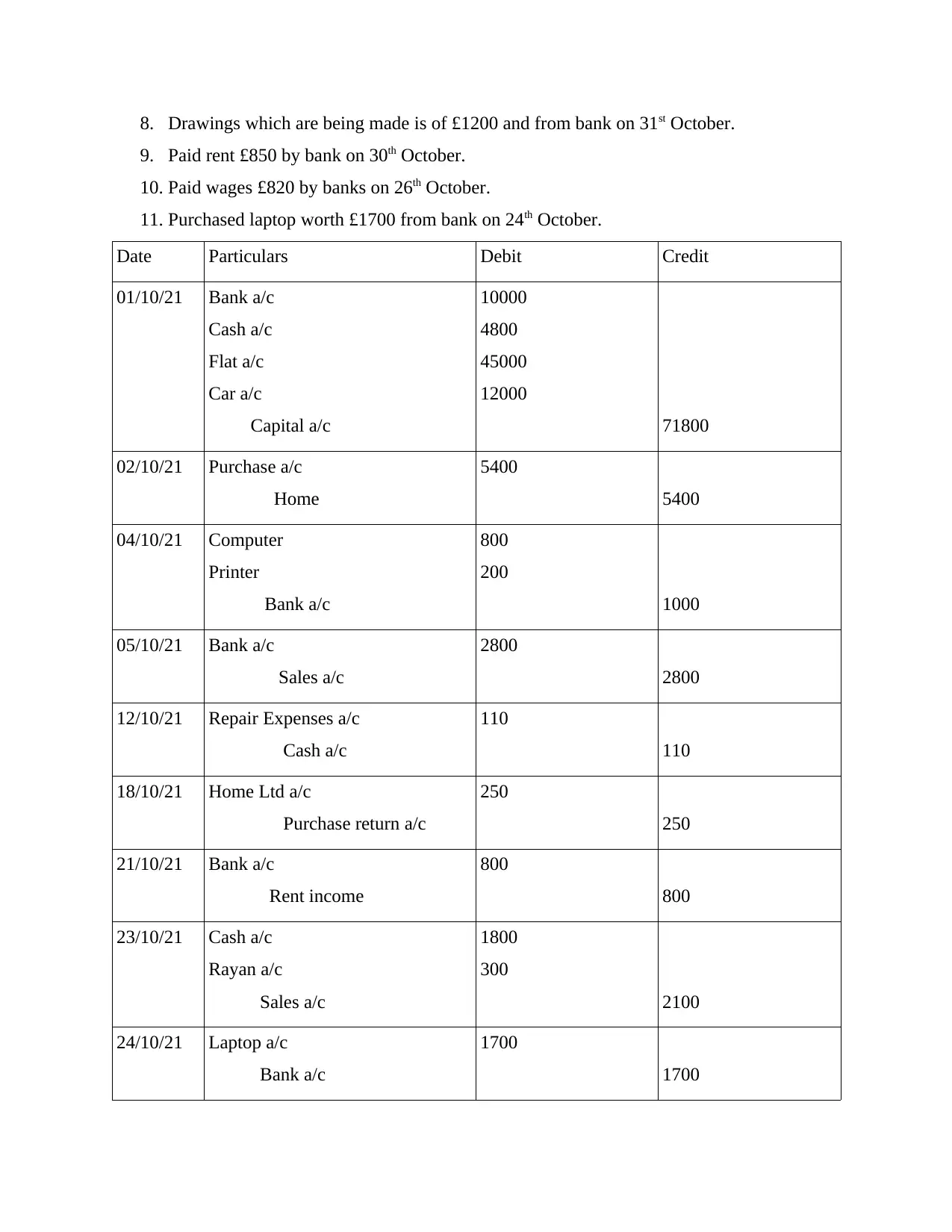
8. Drawings which are being made is of £1200 and from bank on 31st October.
9. Paid rent £850 by bank on 30th October.
10. Paid wages £820 by banks on 26th October.
11. Purchased laptop worth £1700 from bank on 24th October.
Date Particulars Debit Credit
01/10/21 Bank a/c
Cash a/c
Flat a/c
Car a/c
Capital a/c
10000
4800
45000
12000
71800
02/10/21 Purchase a/c
Home
5400
5400
04/10/21 Computer
Printer
Bank a/c
800
200
1000
05/10/21 Bank a/c
Sales a/c
2800
2800
12/10/21 Repair Expenses a/c
Cash a/c
110
110
18/10/21 Home Ltd a/c
Purchase return a/c
250
250
21/10/21 Bank a/c
Rent income
800
800
23/10/21 Cash a/c
Rayan a/c
Sales a/c
1800
300
2100
24/10/21 Laptop a/c
Bank a/c
1700
1700
9. Paid rent £850 by bank on 30th October.
10. Paid wages £820 by banks on 26th October.
11. Purchased laptop worth £1700 from bank on 24th October.
Date Particulars Debit Credit
01/10/21 Bank a/c
Cash a/c
Flat a/c
Car a/c
Capital a/c
10000
4800
45000
12000
71800
02/10/21 Purchase a/c
Home
5400
5400
04/10/21 Computer
Printer
Bank a/c
800
200
1000
05/10/21 Bank a/c
Sales a/c
2800
2800
12/10/21 Repair Expenses a/c
Cash a/c
110
110
18/10/21 Home Ltd a/c
Purchase return a/c
250
250
21/10/21 Bank a/c
Rent income
800
800
23/10/21 Cash a/c
Rayan a/c
Sales a/c
1800
300
2100
24/10/21 Laptop a/c
Bank a/c
1700
1700
Paraphrase This Document
Need a fresh take? Get an instant paraphrase of this document with our AI Paraphraser
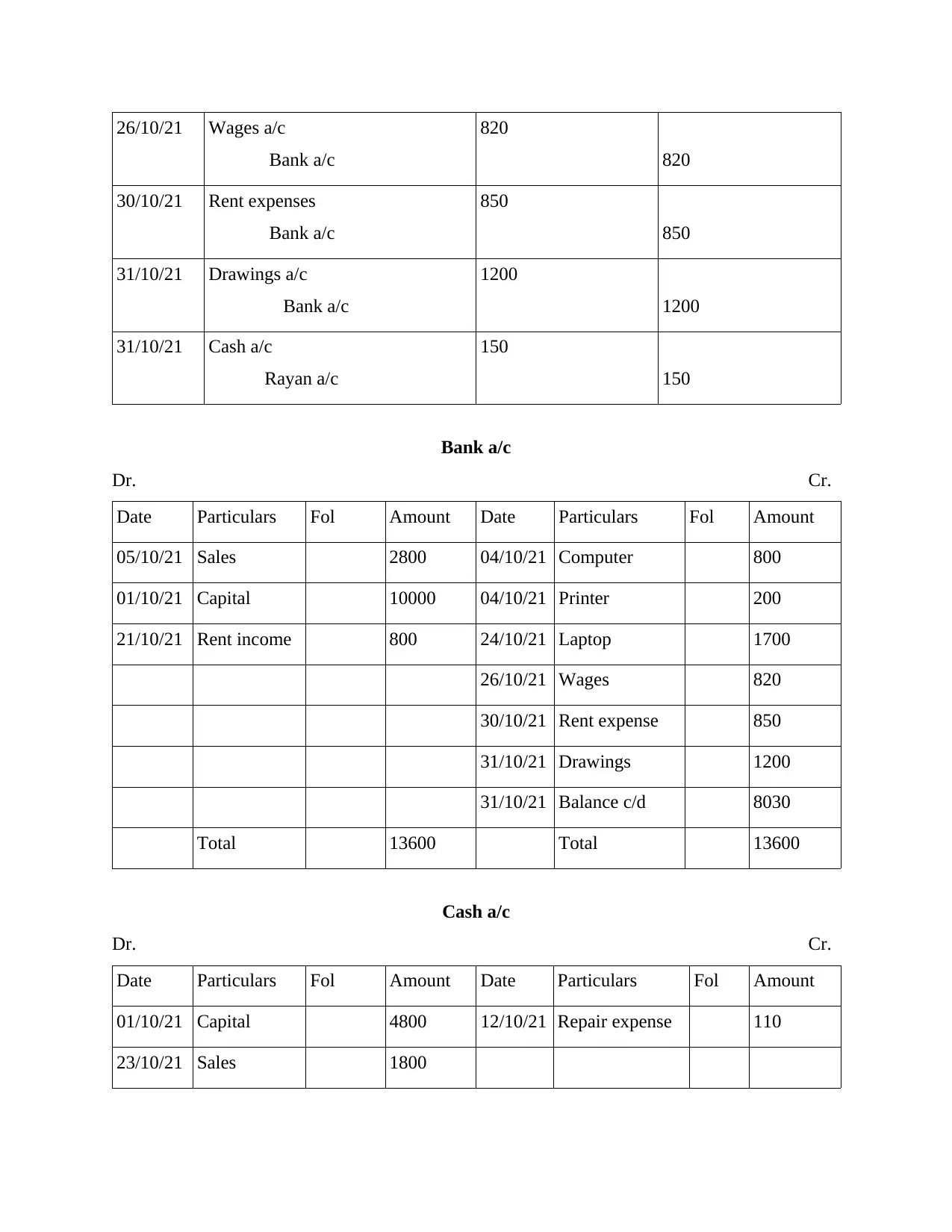
26/10/21 Wages a/c
Bank a/c
820
820
30/10/21 Rent expenses
Bank a/c
850
850
31/10/21 Drawings a/c
Bank a/c
1200
1200
31/10/21 Cash a/c
Rayan a/c
150
150
Bank a/c
Dr. Cr.
Date Particulars Fol Amount Date Particulars Fol Amount
05/10/21 Sales 2800 04/10/21 Computer 800
01/10/21 Capital 10000 04/10/21 Printer 200
21/10/21 Rent income 800 24/10/21 Laptop 1700
26/10/21 Wages 820
30/10/21 Rent expense 850
31/10/21 Drawings 1200
31/10/21 Balance c/d 8030
Total 13600 Total 13600
Cash a/c
Dr. Cr.
Date Particulars Fol Amount Date Particulars Fol Amount
01/10/21 Capital 4800 12/10/21 Repair expense 110
23/10/21 Sales 1800
Bank a/c
820
820
30/10/21 Rent expenses
Bank a/c
850
850
31/10/21 Drawings a/c
Bank a/c
1200
1200
31/10/21 Cash a/c
Rayan a/c
150
150
Bank a/c
Dr. Cr.
Date Particulars Fol Amount Date Particulars Fol Amount
05/10/21 Sales 2800 04/10/21 Computer 800
01/10/21 Capital 10000 04/10/21 Printer 200
21/10/21 Rent income 800 24/10/21 Laptop 1700
26/10/21 Wages 820
30/10/21 Rent expense 850
31/10/21 Drawings 1200
31/10/21 Balance c/d 8030
Total 13600 Total 13600
Cash a/c
Dr. Cr.
Date Particulars Fol Amount Date Particulars Fol Amount
01/10/21 Capital 4800 12/10/21 Repair expense 110
23/10/21 Sales 1800
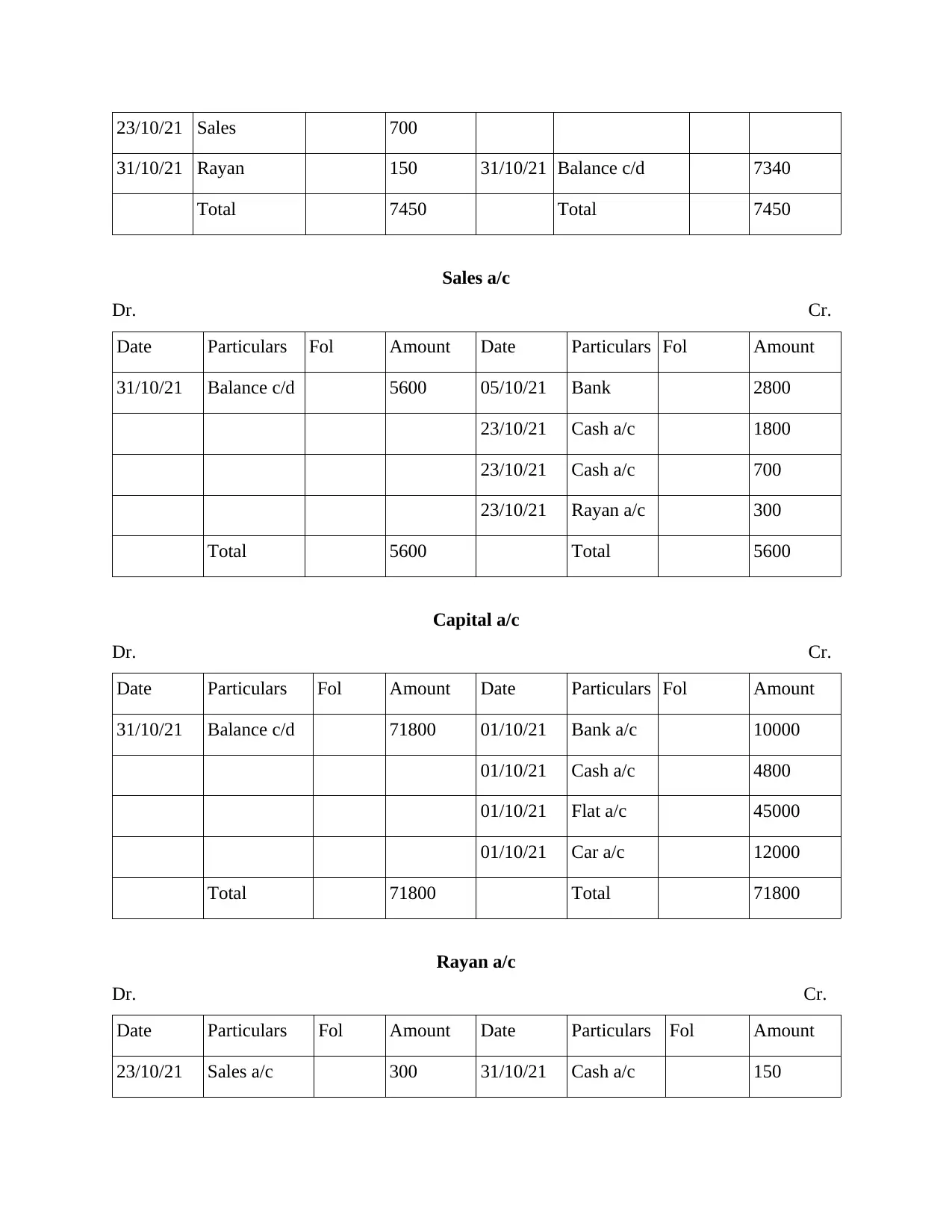
23/10/21 Sales 700
31/10/21 Rayan 150 31/10/21 Balance c/d 7340
Total 7450 Total 7450
Sales a/c
Dr. Cr.
Date Particulars Fol Amount Date Particulars Fol Amount
31/10/21 Balance c/d 5600 05/10/21 Bank 2800
23/10/21 Cash a/c 1800
23/10/21 Cash a/c 700
23/10/21 Rayan a/c 300
Total 5600 Total 5600
Capital a/c
Dr. Cr.
Date Particulars Fol Amount Date Particulars Fol Amount
31/10/21 Balance c/d 71800 01/10/21 Bank a/c 10000
01/10/21 Cash a/c 4800
01/10/21 Flat a/c 45000
01/10/21 Car a/c 12000
Total 71800 Total 71800
Rayan a/c
Dr. Cr.
Date Particulars Fol Amount Date Particulars Fol Amount
23/10/21 Sales a/c 300 31/10/21 Cash a/c 150
31/10/21 Rayan 150 31/10/21 Balance c/d 7340
Total 7450 Total 7450
Sales a/c
Dr. Cr.
Date Particulars Fol Amount Date Particulars Fol Amount
31/10/21 Balance c/d 5600 05/10/21 Bank 2800
23/10/21 Cash a/c 1800
23/10/21 Cash a/c 700
23/10/21 Rayan a/c 300
Total 5600 Total 5600
Capital a/c
Dr. Cr.
Date Particulars Fol Amount Date Particulars Fol Amount
31/10/21 Balance c/d 71800 01/10/21 Bank a/c 10000
01/10/21 Cash a/c 4800
01/10/21 Flat a/c 45000
01/10/21 Car a/c 12000
Total 71800 Total 71800
Rayan a/c
Dr. Cr.
Date Particulars Fol Amount Date Particulars Fol Amount
23/10/21 Sales a/c 300 31/10/21 Cash a/c 150
⊘ This is a preview!⊘
Do you want full access?
Subscribe today to unlock all pages.

Trusted by 1+ million students worldwide
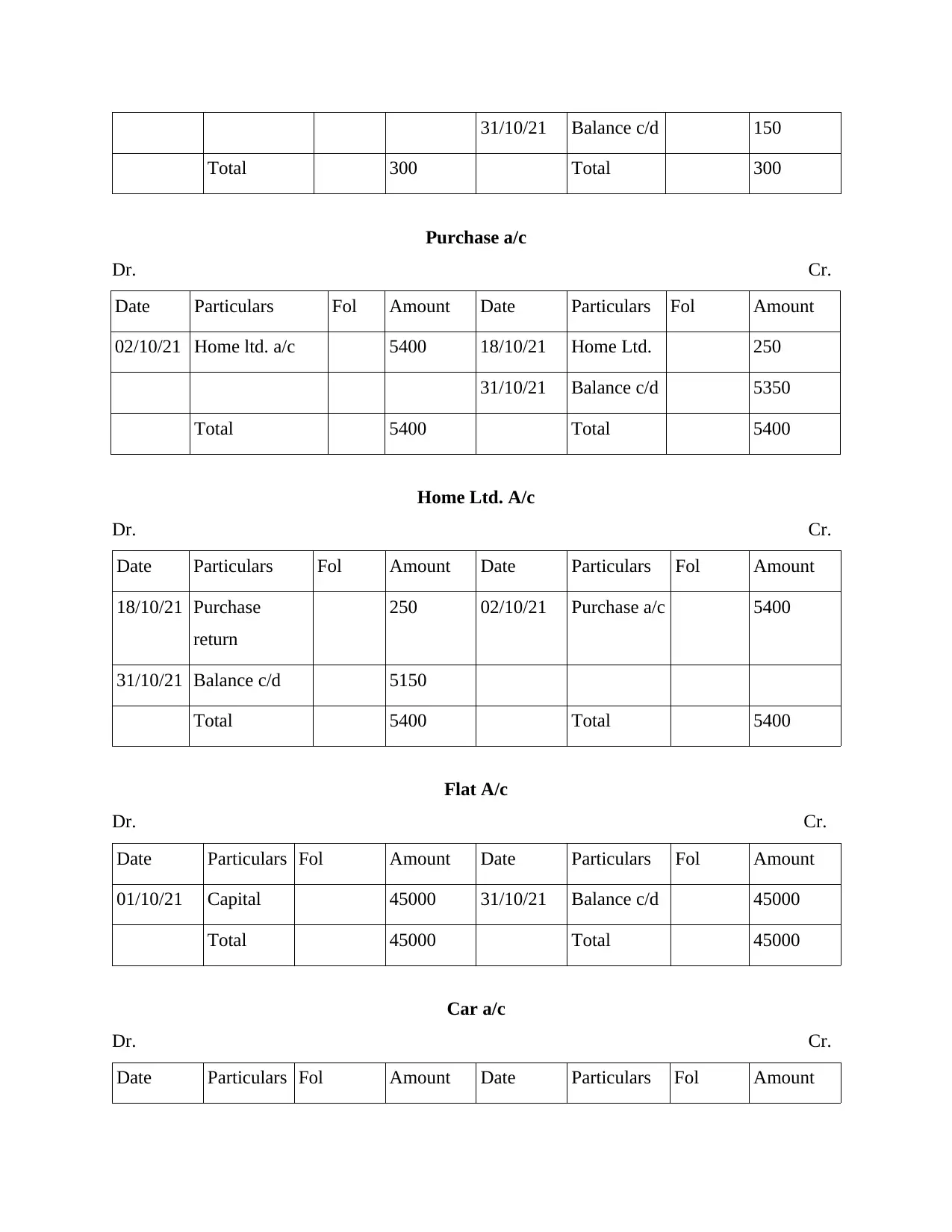
31/10/21 Balance c/d 150
Total 300 Total 300
Purchase a/c
Dr. Cr.
Date Particulars Fol Amount Date Particulars Fol Amount
02/10/21 Home ltd. a/c 5400 18/10/21 Home Ltd. 250
31/10/21 Balance c/d 5350
Total 5400 Total 5400
Home Ltd. A/c
Dr. Cr.
Date Particulars Fol Amount Date Particulars Fol Amount
18/10/21 Purchase
return
250 02/10/21 Purchase a/c 5400
31/10/21 Balance c/d 5150
Total 5400 Total 5400
Flat A/c
Dr. Cr.
Date Particulars Fol Amount Date Particulars Fol Amount
01/10/21 Capital 45000 31/10/21 Balance c/d 45000
Total 45000 Total 45000
Car a/c
Dr. Cr.
Date Particulars Fol Amount Date Particulars Fol Amount
Total 300 Total 300
Purchase a/c
Dr. Cr.
Date Particulars Fol Amount Date Particulars Fol Amount
02/10/21 Home ltd. a/c 5400 18/10/21 Home Ltd. 250
31/10/21 Balance c/d 5350
Total 5400 Total 5400
Home Ltd. A/c
Dr. Cr.
Date Particulars Fol Amount Date Particulars Fol Amount
18/10/21 Purchase
return
250 02/10/21 Purchase a/c 5400
31/10/21 Balance c/d 5150
Total 5400 Total 5400
Flat A/c
Dr. Cr.
Date Particulars Fol Amount Date Particulars Fol Amount
01/10/21 Capital 45000 31/10/21 Balance c/d 45000
Total 45000 Total 45000
Car a/c
Dr. Cr.
Date Particulars Fol Amount Date Particulars Fol Amount
Paraphrase This Document
Need a fresh take? Get an instant paraphrase of this document with our AI Paraphraser
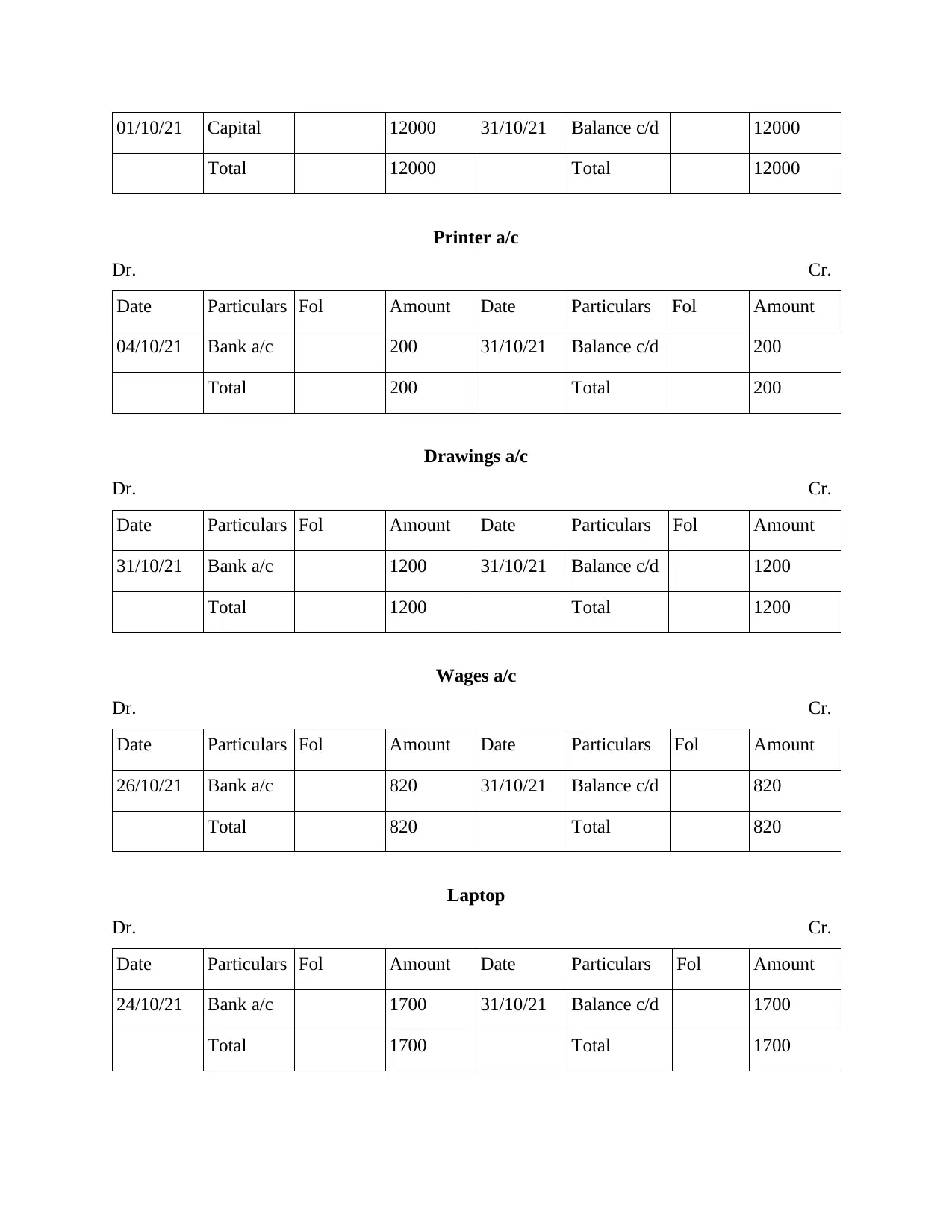
01/10/21 Capital 12000 31/10/21 Balance c/d 12000
Total 12000 Total 12000
Printer a/c
Dr. Cr.
Date Particulars Fol Amount Date Particulars Fol Amount
04/10/21 Bank a/c 200 31/10/21 Balance c/d 200
Total 200 Total 200
Drawings a/c
Dr. Cr.
Date Particulars Fol Amount Date Particulars Fol Amount
31/10/21 Bank a/c 1200 31/10/21 Balance c/d 1200
Total 1200 Total 1200
Wages a/c
Dr. Cr.
Date Particulars Fol Amount Date Particulars Fol Amount
26/10/21 Bank a/c 820 31/10/21 Balance c/d 820
Total 820 Total 820
Laptop
Dr. Cr.
Date Particulars Fol Amount Date Particulars Fol Amount
24/10/21 Bank a/c 1700 31/10/21 Balance c/d 1700
Total 1700 Total 1700
Total 12000 Total 12000
Printer a/c
Dr. Cr.
Date Particulars Fol Amount Date Particulars Fol Amount
04/10/21 Bank a/c 200 31/10/21 Balance c/d 200
Total 200 Total 200
Drawings a/c
Dr. Cr.
Date Particulars Fol Amount Date Particulars Fol Amount
31/10/21 Bank a/c 1200 31/10/21 Balance c/d 1200
Total 1200 Total 1200
Wages a/c
Dr. Cr.
Date Particulars Fol Amount Date Particulars Fol Amount
26/10/21 Bank a/c 820 31/10/21 Balance c/d 820
Total 820 Total 820
Laptop
Dr. Cr.
Date Particulars Fol Amount Date Particulars Fol Amount
24/10/21 Bank a/c 1700 31/10/21 Balance c/d 1700
Total 1700 Total 1700
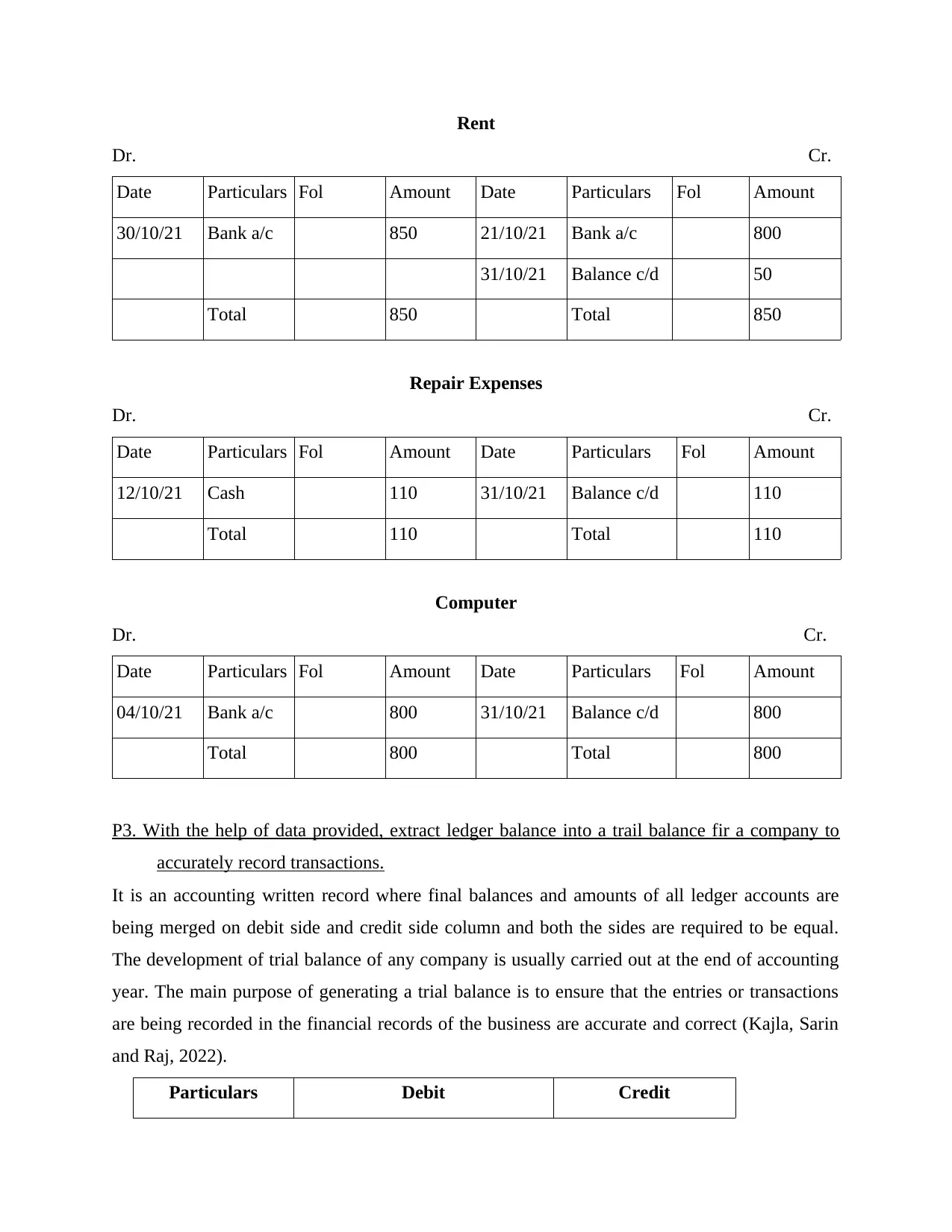
Rent
Dr. Cr.
Date Particulars Fol Amount Date Particulars Fol Amount
30/10/21 Bank a/c 850 21/10/21 Bank a/c 800
31/10/21 Balance c/d 50
Total 850 Total 850
Repair Expenses
Dr. Cr.
Date Particulars Fol Amount Date Particulars Fol Amount
12/10/21 Cash 110 31/10/21 Balance c/d 110
Total 110 Total 110
Computer
Dr. Cr.
Date Particulars Fol Amount Date Particulars Fol Amount
04/10/21 Bank a/c 800 31/10/21 Balance c/d 800
Total 800 Total 800
P3. With the help of data provided, extract ledger balance into a trail balance fir a company to
accurately record transactions.
It is an accounting written record where final balances and amounts of all ledger accounts are
being merged on debit side and credit side column and both the sides are required to be equal.
The development of trial balance of any company is usually carried out at the end of accounting
year. The main purpose of generating a trial balance is to ensure that the entries or transactions
are being recorded in the financial records of the business are accurate and correct (Kajla, Sarin
and Raj, 2022).
Particulars Debit Credit
Dr. Cr.
Date Particulars Fol Amount Date Particulars Fol Amount
30/10/21 Bank a/c 850 21/10/21 Bank a/c 800
31/10/21 Balance c/d 50
Total 850 Total 850
Repair Expenses
Dr. Cr.
Date Particulars Fol Amount Date Particulars Fol Amount
12/10/21 Cash 110 31/10/21 Balance c/d 110
Total 110 Total 110
Computer
Dr. Cr.
Date Particulars Fol Amount Date Particulars Fol Amount
04/10/21 Bank a/c 800 31/10/21 Balance c/d 800
Total 800 Total 800
P3. With the help of data provided, extract ledger balance into a trail balance fir a company to
accurately record transactions.
It is an accounting written record where final balances and amounts of all ledger accounts are
being merged on debit side and credit side column and both the sides are required to be equal.
The development of trial balance of any company is usually carried out at the end of accounting
year. The main purpose of generating a trial balance is to ensure that the entries or transactions
are being recorded in the financial records of the business are accurate and correct (Kajla, Sarin
and Raj, 2022).
Particulars Debit Credit
⊘ This is a preview!⊘
Do you want full access?
Subscribe today to unlock all pages.

Trusted by 1+ million students worldwide
1 out of 20
Related Documents
Your All-in-One AI-Powered Toolkit for Academic Success.
+13062052269
info@desklib.com
Available 24*7 on WhatsApp / Email
![[object Object]](/_next/static/media/star-bottom.7253800d.svg)
Unlock your academic potential
Copyright © 2020–2025 A2Z Services. All Rights Reserved. Developed and managed by ZUCOL.





